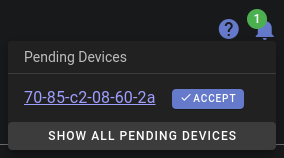Buildroot
This guide provides instructions for integrating the ShellHub Agent into a Buildroot-based system, enabling ShellHub’s remote management capabilities.
Prerequisites
- Buildroot Environment: Ensure you have Buildroot installed on your system.
- ShellHub Access: A valid tenant ID for your ShellHub Cloud or self-hosted instance.
- QEMU: Installed and configured for emulated environments (optional).
Step 1: Cloning Repositories
Clone the Buildroot repository:
git clone git://git.buildroot.net/buildroot
Clone the ShellHub external Buildroot tree:
git clone https://github.com/shellhub-io/buildroot.git shellhub
Step 2: Configuring ShellHub Integration
Setting Default Configuration
Navigate to the Buildroot directory and set the default configuration for ShellHub:
cd buildroot
make BR2_EXTERNAL=../shellhub qemu_x86_64_defconfig
Modifying Configuration via Menuconfig
Start the Buildroot menuconfig to customize options. Ensure the ShellHub option is selected under External options:
make BR2_EXTERNAL=../shellhub menuconfig
Step 3: Adding Custom ShellHub Configuration
To customize the ShellHub Agent’s configuration, create a configuration overlay:
nano ../shellhub/rootfs_overlay/etc/default/shellhub-agent
Put the following content:
SERVER_ADDRESS="https://cloud.shellhub.io"
TENANT_ID="<your-tenant-id-here>"
PRIVATE_KEY="/etc/shellhub-agent.key"
Replace the placeholder values. For more information see ShellHub Environment Variables for BuildRoot..
Step 4: Building the System
Build the root filesystem and kernel:
make BR2_EXTERNAL=../shellhub rootfs-ext2
This command generates the system images required for your device.
Step 5: Running With QEMU (Optional)
To test your Buildroot system with ShellHub in an emulated environment, run:
qemu-system-x86_64 \
-kernel output/images/bzImage \
-drive file=output/images/rootfs.ext2,format=raw \
-append "root=/dev/sda console=ttyS0" \
-m 512M \
-nographic \
-netdev user,id=n0,hostfwd=tcp::2222-:22 \
-device virtio-net-pci,netdev=n0

Troubleshooting
-
Configuration File Not Applied: Check the log file
/var/log/shellhub-agent.logfor error messages. If the agent fails to load configuration or reportsfailed to parse the configuration, ensure theshellhub-agentconfiguration file is correctly placed in/etc/default/. Double-check variable names and values, especially forSERVER_ADDRESS,PRIVATE_KEY, andTENANT_ID. -
Network Connectivity Issues: If the agent cannot connect to the server, confirm that the network interface is properly configured and active. Verify connectivity by testing with a tool like
pingorcurlfrom within the target system. -
Build Errors: If Buildroot fails during compilation, ensure all dependencies are satisfied and that external trees (e.g., ShellHub) are correctly referenced with
BR2_EXTERNAL. Verify any addedConfig.inmodifications do not conflict with existing configurations.
ShellHub Environment Variables for BuildRoot
- SERVER_ADDRESS: Your ShellHub server address. Keep
https://cloud.shellhub.ioif you're using ShellHub Cloud. - PRIVATE_KEY: Path to your private key file.
- TENANT_ID: Links the device to a specific tenant or namespace. For help retrieving this, see Retrieving Your Tenant ID.
Conclusion
By integrating ShellHub into your Buildroot system, you enable seamless remote management of your device. For more information on Buildroot, refer to the Buildroot Manual.